
Features
Safety
Fundamental Approach
What do you think when you see the words “test pilot”?
July 14, 2010 By James Careless
What do you think when you see the words “test pilot”? Do you think of steely-eyed, rock-jawed fighter jocks willing to push cutting-edge aircraft past the limits? Do you imagine fearless risk-takers with ice water in their veins, skimming prototype jets mere inches above the earth, then rocketing vertically into the heavens?
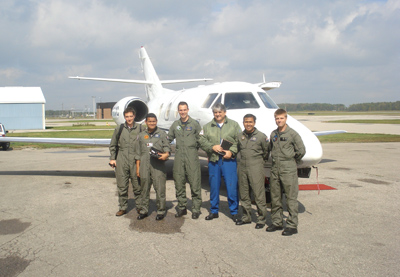 |
|
| Giorgio Clementi, third from right, with students at the International Test Pilot School. PHOTO: itps
|
The real world test pilot is not a daredevil. In real life, a test pilot is a methodical, highly-organized professional who flies prototypes according to highly detailed and rigid flight test plans. “I always tell my students the objective of test planning is to make the flight as boring as possible,” says Giorgio Clementi. “If the test flight suddenly becomes exciting, it’s probably because you’ve done something wrong.”
Clementi is a veteran flight test engineer, test pilot, aviation consultant, and president of the International Test Pilot School (ITPS). The ITPS is based at the London (Ontario) International Airport, sharing facilities with the Jet Aviation Museum (where Clementi is also director of flight operations). Clementi has been involved in flight testing since 1987 and training test pilots since 1991. His career spans 26 years in aviation, including instructing pilots and engineers from 18 countries. He has gathered an international team of highly-skilled instructors, including retired Canadian astronaut Bjarni Trygvasson, to provide a variety of training programs for flight testers in Canada.
“Our goal is to teach pilots and engineers – usually military fliers sent to us by industry or air forces – the fundamental approach and methods of real world flight test work,” Clementi says. “We train them here in London in the classroom and aloft in a variety of fixed and rotary wing aircraft. We have also travelled to the customers’ countries to provide training in the aircraft and environment in which they operate everyday.”
A cornerstone of flight test training is exposing student flight testers to a variety of aircraft and avionics systems, typically 20 types or more on a typical Graduate Flight Test Course. Aircraft used by ITPS recently and on past programs have included the Dassault Falcon 10, Bell 412 (the Variable Stability 412 owned by the National Research Council), Piper Cheyenne, Mitsubishi MU-2, as well as the F-104, F-18, T-38, T-33, SIAI S-211 and Aero Vodochody L-39. (In most instances, ITPS uses London-based aircraft. In others, it has access to private aircraft and those provided by government agencies in Canada and abroad.)
The Curriculum
ITPS offers a number of options for test pilot and flight test engineer training. The graduate course prepares students for the entire process of flight-testing, namely test planning, test flying, data analysis and report writing. Elements of the course are available as short courses on specific topics such as: flight testing avionics and weapons systems; understanding flight performance; learning to use Night Vision Systems; and a two-week “Introduction to Flight Test.”
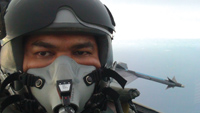 |
|
| ITPS student pilot. PHOTOs: itps |
The school’s emphasis is on students understanding the underlying theory of flight to a much greater depth than the average operational pilot. They also need to develop a disciplined and methodical, step-by-step approach to test planning and flight-testing, including testing prototype aircraft.
“Students have to learn how to quickly familiarize themselves with the crucial systems and limitations of a given airplane or helicopter – because we train both helicopter and airplane flight testers – and to learn the aircraft’s avionics, performance envelope and limitations,” says Clementi. “They then have to learn how to assess the risks associated with a given flight test and take mitigating precautions. Thereafter, they apply the test techniques taught in the classroom and demonstrated to them in flight. The process is to teach them in the classroom, demonstrate in flight and then set them loose to conduct an evaluation independently, but supervised by our instructors.”
Another key aspect to the training is to enable students to analyze the data recorded in flight and draw conclusions on the aircraft or systems suitability for its intended application. This must be communicated in the form of written reports and oral presentations.
The logic of test flying
Would you strap yourself into an aircraft that has never flown before and roar down the runway with no clue as to the aircraft’s stall speed, safe rate of climb, or thresholds at which problems such as flutter (naturally-occurring vibrations of the wings, which can lead to catastrophic failure) manifest themselves? If you had no desire to make a second flight, then your answer would be “yes.” But if you are a professional test pilot – the kind ITPS trains – then your answer would most definitely be “no.”
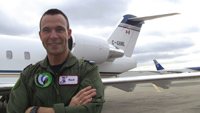 |
|
| Maj. Bruno Beeckmans, Belgian AF, with the Challenger 604 he flew for his final project last December. PHOTOs: itps
|
Knowing what might happen is why professional test pilots start by first sitting down with the people who designed and built the prototype. The pilot’s goal is to understand the limits of the new aircraft – what it can and cannot theoretically do in flight. They want to know its stall speed, its safe rate of climb, permissible load factors and anything else that defines this aircraft’s individual flight envelope. Next, the test crew wants to work out, on a step-by-step basis, the precise profile and manoeuvres they will put the prototype through such that key parameters may be measured by themselves or by onboard recording equipment, as well as observers in other aircraft or at a telemetry station on the ground.
“In the case of a first flight, the goal is usually to conduct an initial assessment of the aircraft, within a limited but safe envelope determined by the engineers in consultation with the flight test department,” says Clementi. “The scope and complexity of the flight will depend on the organization and the level of confidence in the engineering of the prototype. However, in this flight, you want to take a particularly careful approach – get up to the predetermined test altitude, never exceeding pre-determined speeds, and staying well above the stall speed – usually no less than a factor of 1.4 times faster than stall at all times.”
By the time they have reached the test altitude, the pilot will have formed an initial opinion of the aircraft’s response and handling. The pilot will thus be able to tell the test director if he/she is prepared to progress with the test card, which will include stability assessments and one or more approaches to the stall as he needs to know how the airplane will handle when slowing down for the approach to land. Each test point on the card is incrementally cleared up to the planned maximum and minimum speeds and altitudes. All the tests are conducted under the watchful eye of the crew in the chase airplane, who ensure no “bits” fall off the test airplane and no unusual structural response or leaks develop on the prototype.
Only after the prototype has successfully functioned within this envelope, can the envelope be “opened up.” In other words, the test pilot can now take the aircraft faster and higher, and get closer to the maximum design and critical stall speeds. But even in doing this, there are no top gun heroics. Everything the test pilot does in the air is based on a detailed flight test plan that they and the engineers drew up before takeoff.
“As you open up the envelope, you test for flutter and this is hazardous flight testing,” Clementi says. “You don’t make radical changes only planned incremental changes, because you want to be ready and able to back off if ‘surprises’ happen. Sometimes surprises – such as flutter or loss of control – can be a cliff-edge effect: One second the aircraft is fine, the next it is in trouble due to a bit more speed being applied or a slightly higher angle of attack. The test pilot should be prepared for this, and to employ the appropriate recovery action, bringing himself and the aircraft safely back to earth.”
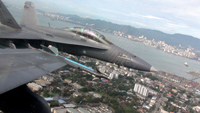 |
|
| A cornerstone of flight test training is exposing student flight testers to a variety of aircraft and avionics systems. PHOTOs: itps
|
It is this kind of controlled calm that defines the “right stuff” in a test pilot, rather than ego or a desire for glory. Giorgio Clementi knows this from experience, having faced a number of “surprises” when flying prototypes.
“I recall one occasion that a flight engineer and I were testing a new jet, when a safety related system caught fire,” he says. “This flight test specific equipment had been installed to save our lives in an emergency, enabling us to abandon the aircraft, but on that occasion it actually caused the emergency!”
“What saved us was the fact we properly briefed including the emergency procedures checklist before we took off. So, when the fire broke out, we responded in a coordinated fashion as a crew despite a significant amount of smoke in the cockpit. The result is we got ourselves and the aircraft back on the ground intact and in one piece, which is really the point of the job.”
Got the Right Stuff?
At first glance, the ITPS would seem to be the exclusive preserve of military pilots. After all, they are the ones with access to government-funded aircraft and training. Surely there’s no room for civilians in this kind of club?
Well, actually there is – although weekend pilots who like to fly their Cessnas slowly should probably not apply. “We do get civilian pilots here from time to time,” says Giorgio Clementi. “Typically, they are industry sponsored or high flight time private individuals who fly for a living, who wish to work their way into flight testing or simply want to learn more. All our candidates have a real passion for flight and want to understand it on the deeper level that test piloting offers.”
For these people, and the military pilots who attend ITPS in London, Clementi and his team of skilled instructors are happy to share their expertise – safely, smartly and with the utmost respect for the real limits of flight.
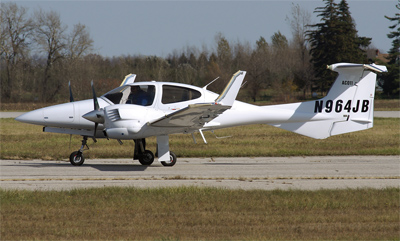 Girorgio Clementi taxies a DA-42 with simulated ice shapes on wings and empennage. The Learning Curve – state-of-the-art training at itps It is vital for any educational establishment to keep abreast of latest developments in technology and techniques. ITPS is no exception and Giorgio Clementi has strived to strike a balance between training and consulting services. Since establishing ITPS in Canada in 1991, Giorgio has been contracted to the flight test departments of Agusta, Bell Helicopter, GROB Aerospace and Diamond Aircraft, both in Austria and Canada. This has provided an opportunity to participate in flight test programs of state-of-the-art aircraft and avionics. The breadth of expertise includes Cockpit and Workload Assessment, Helicopter Performance and Handling Qualities to civil and military requirements, Power plant and Systems certification, Flight Into Known Icing certification as well as a complete Proof of Concept Aircraft flight test program. Further, the other members of the team bring their own considerable body of professional experience. This breadth and depth of expertise is essential to ensuring that ITPS training reflects current industry best practices, technology and test methods. The customers for ITPS training are principally foreign air forces. Prior to incorporating ITPS in Canada, Giorgio had provided training in the U.K. to 15 different air forces including the Canadian Forces, the Royal Australian Air Force, the Czech AF and the Spanish Air Force. He also provided specially designed programs for civil entities such as IPTN Indonesia, Fairchild Dornier and Embraer and Eurocopter Germany. Students for the 2009 course came from as far a field as Malaysia, Belgium, Romania and Canada. |